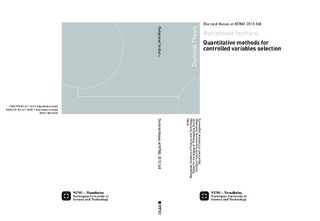| dc.contributor.author | Yelchuru, Ramprasad | nb_NO |
| dc.date.accessioned | 2014-12-19T13:23:38Z | |
| dc.date.available | 2014-12-19T13:23:38Z | |
| dc.date.created | 2012-10-10 | nb_NO |
| dc.date.issued | 2012 | nb_NO |
| dc.identifier | 560031 | nb_NO |
| dc.identifier.isbn | 978-82-471-3627-0 (printed version) | nb_NO |
| dc.identifier.isbn | 978-82-471-3628-7 (electronic version) | nb_NO |
| dc.identifier.uri | http://hdl.handle.net/11250/248310 | |
| dc.description.abstract | Optimal operation is important to improve productivity to be more competitive, and therefore, increase profitability. Optimal operation can be viewed to constitute the control layer (supervisory layer plus regulatory layer) and optimization layer in the hierarchical decomposition of plantwide control. The task of control layer is to keep controlled variables at given set points and the task of optimization layer is to provide optimal set points. For simple implementation, we want to update the set points less frequently while obtaining an acceptable loss in the presence of disturbances. This can be achieved by appropriate controlled variables selection and keeping them at constant set points. This approach is termed as “self-optimizing control” as this approach automatically lead the operation close to optimal operation. Physically, in self-optimizing control, the selected controlled variables can be seen as the set of variables whose optimal values are insensitive to disturbances and controlling these (at constant set point) would reduce the need for frequent set point updates. The selected controlled variables obtained in “self-optimizing control” link the optimization layer and the control layer.
Self-optimizing control provides a mathematical framework and we use this framework to select the controlled variables c as linear combinations of measurements y, c = Hy, with the aim to minimize the steady state loss from optimal operation. In “self-optimizing control”, we keep the controlled variables c at constant set points using feedback, and this feedback introduces implementation errors. The focus of this thesis is to devise systematic and good methods to arrive at controlled variables by finding optimal H that minimize the steady state loss of optimality in the presence of both disturbances and implementation errors.
There are three main contributions in this thesis. The first contribution is to provide (i) a convex formulation to find the optimal combination matrix H for a given measurement set, and (ii) a Mixed-Integer Quadratic Programming (MIQP) methodology to select optimal measurement subsets that result in minimal steady state loss in the presence of disturbances. The methods provided in this thesis are exact for quadratic problems with linear measurement relations. The MIQP methods can handle additional structural constraints compared to the Branch and Bound (BAB) methods reported in literature for these problems. The MIQP methods are evaluated on a toy example, an evaporator example, a binary distillation column example with 41 stages and a Kaibel column example with 71 stages.
Second contribution is to develop convex approximation methods that incorporate structural constraints to improve the dynamic controllability properties, such as fast response, control loop localization and to reduce time delays between the manipulated variables (u) and the controlled variables (c). For these cases, H is structured, for example, decentralized H or triangular H. The decentralized H is to obtain c as combination of measurements of a individual process unit. These structured H cases in self-optimizing control are non-convex. Hence, we propose a few new ideas and convex approximation methods to obtain good upper bounds for these structured H problems. The proposed methods are evaluated on random cases, an evaporator case study and a binary distillation column case study with 41 stages.
Third contribution is to extend the self-optimizing control ideas to find optimal controlled variables in the regulatory layer. The regulatory layer is designed to facilitate stable operation, to regulate and to keep the operation in the linear operating range. The regulatory layer performance is quantified using the state drift criterion. Quantitative method for the regulatory layer selection with one, two or more closed loops is proposed to minimize the drift in states. The proposed quantitative methods are evaluated on a distillation column with 41 stages and a Kaibel column with 71 stages case studies.
To summarize, in self-optimizing control, for selecting the controlled variables c as linear combinations of measurements y, c = Hy, (a) we developed MIQP methods that belong to a convex sub class to find globally optimal H and optimal measurement subsets; (b) we developed convex approximation methods to find good upper bounds to find optimal decentralized/triangular H and optimal measurement subsets; (c) we extended the self-optimizing control concepts to find c in the regulatory layer and proposed a quantitative method that minimizes the state drift to arrive at optimal regulatory layer with 1, 2 or more closed loops.
In conclusion, we developed quantitative methods for controlled variables selection in both supervisory layer and regulatory control layer. We demonstrated the developed methods on a few representative case studies. | nb_NO |
| dc.language | eng | nb_NO |
| dc.publisher | Norges teknisk-naturvitenskapelige universitet, Fakultet for naturvitenskap og teknologi, Institutt for kjemisk prosessteknologi | nb_NO |
| dc.relation.ispartofseries | Doktoravhandlinger ved NTNU, 1503-8181; 2012:168 | nb_NO |
| dc.title | Quantitative methods for controlled variables selection | nb_NO |
| dc.type | Doctoral thesis | nb_NO |
| dc.contributor.department | Norges teknisk-naturvitenskapelige universitet, Fakultet for naturvitenskap og teknologi, Institutt for kjemisk prosessteknologi | nb_NO |
| dc.description.degree | PhD i kjemisk prosessteknologi | nb_NO |
| dc.description.degree | PhD in Chemical Engineering | en_GB |
